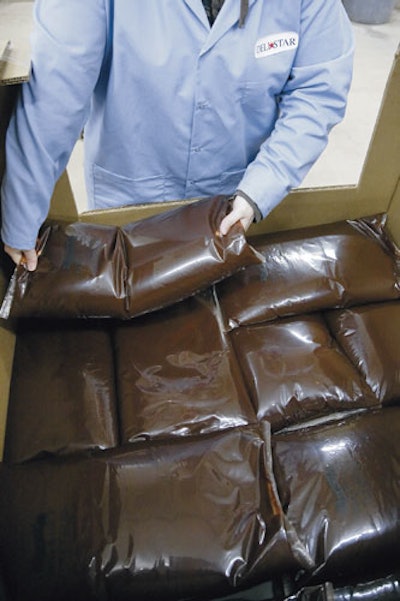Like many bulk liquid processors, Deli Star Corp. of Fayetteville, IL, has experienced both big opportunities, and big challenges, while serving the fast-growing foodservice market. For more than 20 years, Deli Star has been among the Midwest’s premier deli product manufacturers. Offering products that include chicken and tuna salads, diced and shredded meats, dressings, and sauces, among others, the company provides an expanding menu of ready-to-eat meal solutions for the foodservice, food processing, and retail grocery industries.
But an inefficient packaging system—using cumbersome, clipped, premade bags, or bag-in-bucket packages—created operational bottlenecks that limited output for its liquid and semi-liquid food products. The company needed a flexible, reliable packaging alternative that could significantly accelerate throughput, with the versatility to package an array of bulk hot- and cold-fill products and offer rapid payback through system-wide savings.
The answer came in a new bulk-liquid packaging system from Curwood. The company’s recently launched Liquiflex® AV Series vertical form/fill/seal equipment combines an accelerated production speed with simplified setup, operation, changeover, and maintenance. The equipment runs films engineered for bulk liquids, such as Liquiflex® Advance™ film, a proprietary 13-layer structure that allows up to 30% downgauging compared to competitive bulk films. This 3.5-mil film can be used for applications that historically required a 5.0-mil film.
According to Deli Star general manager Justin Siegel, the turnkey system brought together all the right ingredients. “We came across Liquiflex film and equipment through conversations with Curwood, and we were immediately attracted to its combination of competitive cost, versatility, and high-speed throughput,” he says.
System doubles productivity, reduces labor cost
Within weeks after installing their new liquid packaging system in August 2009, Deli Star doubled productivity and reduced the cost of labor in its packaging operations.
The majority of liquid and semi-liquid products Deli Star produces are now packed in 20-lb bags. Previously, the packages were 45-lb bags placed in 5-gal plastic buckets. While the former process topped out at 4,000 lb of product/hr, depending on product type and viscosity, the Liquiflex vf/f/s system has ramped line speeds up to 8,400 lb/hr for products like sauces, with a maximum output of 9,000 lb/hr.
And since the machine only requires one operator, Deli Star was able to reduce labor versus the more time-intensive bag-and-clip method.
Deli Star realized further productivity gains in processing functions with the new packaging as well. Whether hot- or cold-filled, the foods have to be cooked to 7-log lethality to kill bacteria and extend shelf life. Sauces and toppings are cooked before filling, then hot-filled and moved to racks for chilling. When filled, the new bags have a 2-in. profile, allowing them to cool significantly faster than the larger, 45-lb bags could.
Protein salads, on the other hand, are cold-filled, post-pasteurized, and then chilled. In this case, the smaller-profile bags reduce both cook and chill time, helping boost throughput.
Flexibility from pump to finished package
Deli Star quickly found their new equipment was an all-purpose switch-hitter for a range of products and package sizes. It performs equally well for hot-fill products and ambient products, and the packaging process is similar, despite the product type or package size.
Liquids or semi-liquids are placed into a large hopper, where they are agitated and pumped to the packaging machine. Deli Star uses two types of pumping mechanisms for process flexibility based on the product’s viscosity. Less-viscous products like sauces are batched and cooked, then pumped into the machine with a Waukesha positive-displacement pumping system and hot-filled into the bags. More-viscous products, like chicken salad, egg salad, and tuna salad, are dispensed using a Handtmann meat stuffer and are cold-filled.
A standard Allen-Bradley control system controls the process from pump to finished package for reliable product delivery, telling the machine when to start, how fast to run, and when to stop. A color touchscreen provides an easy operator interface with help screens for diagnostics and troubleshooting. The Liquiflex machine’s 50-program expandable-memory function makes it easy for operators to call up machine parameters for a wide variety of sizes and product types. Touchscreen-adjustable, servo-driven components make it simple for Deli Star’s operators to fine-tune any tracking or other adjustments.
The machine forms a bag with a fin or lap seal and bottom end seal; then it fills the bag. Squeeze-nip rollers ensure consistent voiding and zero headspace. A top-end seal is then made, which at the same time forms the bottom seal of the next bag. Pull belts synchronized with a rotary encoder ensure accurate bag length and precise fill consistency.
“When you’re hot-filling 20 pounds of product every 8.5 seconds, a particular challenge is getting that seal strong enough to hold the hot, heavy product,” says Siegel. “The machine has an in-line air-blast cooling process to assist the seal cure and significantly improve cooling time.”
Deli Star installed an in-line Videojet DataFlex® thermal-transfer overprinter on the packaging machine’s universal mounting dock. This allows them to print the Deli Star logo, product name, code, lot number, and ingredient statement directly on the pouch. Printing can be positioned anywhere on the package.
Quick-change artist
Siegel is impressed by the Liquiflex system’s simplified setup and changeover for multiple product types and package sizes. He notes that the ease of operation and intuitive controls dramatically accelerated the learning curve on the new equipment, despite his company’s wide range of packaging applications. “Most machines in this category take about six months for the operator to master,” he says. “With this machine, it took less than a month.”
While the majority of Deli Star’s products are in 20-lb pouches, the new system produces pouches as small as 3 lb, with the flexibility to go up to a 30-lb capacity. Pouch size can be changed in minutes with the tool-less, quick-change forming collar and tool-less unwind mandrel for the film. “Whether we’re running a 20-pound barbecue sauce or a 20-pound chicken salad, we use the same forming collar and film,” explains Siegel. “We can quickly change between a 20-pound bag and a 3.3-pound bag just by changing the forming collar and film.” As for changing between high- and low-viscosity products, switching from the Waukesha liquid pump and Handtmann meat stuffer is as simple as changing a plug.
Memory for preset parameters makes it easy for operators to change settings back and forth between sizes: Once a product is run, the operator simply calls up the setting, feeds the film, and presses “go.”
Since different SKUs are processed in different areas of Deli Star’s plant, the compact mobile Liquiflex machine—with a 4.5 x 4-ft footprint—can be wheeled from one department to another, and it can be positioned for optimum efficiency near coolers or other equipment.
Bulk film delivers under pressure
While the new packaging equipment performed beyond Deli Star’s expectations, the material technology of the 6658-S Liquiflex bulk film equally impressed Siegel and his team. Since making the transition to the new system, Deli Star ships most products in large, 40 x 48-in. bulk bins. That means pouches on the bottom of the containers must stand up to the weight of 2,000 pounds of bags on top of them without tearing, shearing, or bursting. So far, Deli Star has experienced a zero-loss record. “I don’t think we’ve had one package fail since installing the system,” says Siegel.
The bulk films utilize a proprietary new Curwood extrusion technology to produce a 13-layer construction, including redundant nylon and ethylene vinyl alcohol layers, to provide strength, abuse-resistance, and barrier. The increased number of layers in the film provides a strengthening effect, not unlike that in plywood. According to Curwood, the result can offer a significant savings over other bulk films on the market, delivering downgauging opportunities without sacrificing performance characteristics.
But strength was only part of the picture. Liquiflex film’s advanced oxygen, moisture, and light barrier has allowed Deli Star to deliver a 180-day shelf life, while safeguarding product freshness and flavor. The film also provides excellent machinability and heat-seal performance. The material stays soft and clear without hazing during cold or ambient fill. And because the coextrusion is extremely consistent in temperatures up to 212º F, it does not exhibit weak spots to compromise food quality in hot-fill applications. Plus, it delivers consistent fill weights, with no stretching or package distortion.
Ease of use, yield, sanitation please customers
Deli Star’s customers are also pleased with the new packaging format. Once they became familiar with the new pouches, they found them safe, efficient, and easier to handle than the bag-in-bucket pack.
The smooth profile of the pouch eliminates the folds of tail materials or voids between pouches and buckets, offering a sanitary package that reduces the chance of contamination. The format also saves the disposal costs of the unwieldy buckets: Most food processors or operators now landfill buckets, due to a USDA mandate that buckets can no longer be reused or sold without inspection, storage, and washing.
Operators also enjoy virtually 100% product yield, since pouches are dispensed bottom-to-top, maximizing evacuation and minimizing product waste.
Finally, the format provides food preparation efficiencies for heat-and-serve applications, since the bulk-liquid packages can go directly from freezer or cooler to rethermalization in boiling water.
According to Siegel, the benefits of Deli Star’s new packaging system have truly added up. “We’ve doubled our production, significantly improved the speed of secondary operations like post-pasteurization and chilling, and reduced package failure,” he says. “Plus, we’re getting 700 more pounds of packaged products on every pallet for transport savings. By moving to the Liquiflex system, we’ve realized efficiencies and savings in every area.”



















